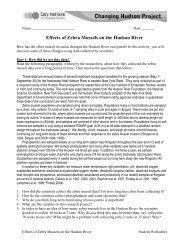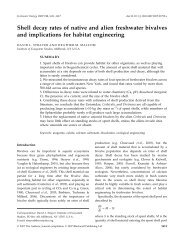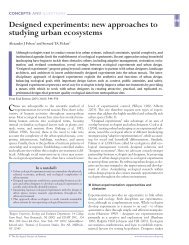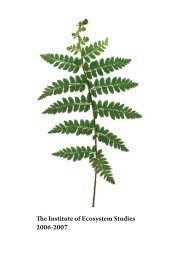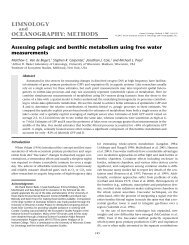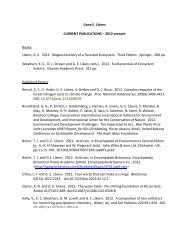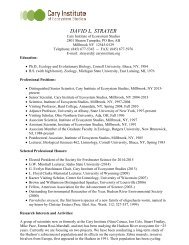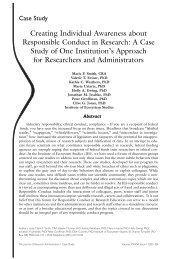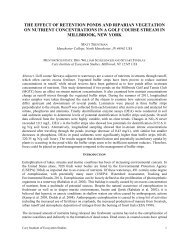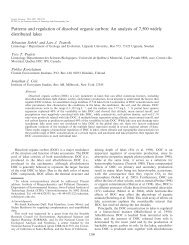Patch dynamics in a landscape modified by ecosystem engineers
Patch dynamics in a landscape modified by ecosystem engineers
Patch dynamics in a landscape modified by ecosystem engineers
Create successful ePaper yourself
Turn your PDF publications into a flip-book with our unique Google optimized e-Paper software.
(and to a lesser degree, to changes <strong>in</strong> r). Given the addeddifficulty of determ<strong>in</strong><strong>in</strong>g analytical solutions to the morecomplex model and estimat<strong>in</strong>g an additional parameter,the benefits of the four-patch model seem limited. Only<strong>in</strong> systems where there are important differences betweenpartially recovered and fully recovered patches, e.g.between the vegetation of beaver meadows and riparianzone forest (Terwilliger and Pastor 1999, Wright et al.2002), would it be worthwhile to model the patch<strong>dynamics</strong> of the system us<strong>in</strong>g the four-patch model.Immigration, either from outside the boundaries ofthe system, or from patches with<strong>in</strong> the system whereeng<strong>in</strong>eers can reproduce without hav<strong>in</strong>g to modifyhabitat has the potential to alter the <strong>dynamics</strong> of thesystem. With even small amounts of immigration, thezero eng<strong>in</strong>eer steady state is no longer possible. Theeffects of immigration will be highest when eng<strong>in</strong>eersreside <strong>in</strong> a patch for a short time (i.e. high d), producefew successful colonizers (i.e. low n), and where degradedpatches recover rapidly (i.e. low r).Model parametersWhile the relative abundance of different patch types <strong>in</strong> a<strong>landscape</strong> can be relatively easy to determ<strong>in</strong>e, estimat<strong>in</strong>gthe parameters of the model is somewhat more challeng<strong>in</strong>g.Although we were able to estimate some of themodel parameters <strong>in</strong>directly us<strong>in</strong>g data on beaverpopulations and patch transitions <strong>in</strong> the central Adirondacks,we are unaware of any data set that wouldallow <strong>in</strong>dependent estimation of all of the model’sparameters. Future studies of the effects of <strong>ecosystem</strong>eng<strong>in</strong>eers on patch <strong>dynamics</strong> would benefit <strong>by</strong> structur<strong>in</strong>gtheir questions <strong>in</strong> a manner that would allow<strong>in</strong>vestigators to estimate the parameters of these models.Of all the parameters, d, or the rate at which activesites are abandoned, is likely to be the easiest to estimate.Careful long-term monitor<strong>in</strong>g of patch use <strong>by</strong> eng<strong>in</strong>eerswill yield average lifetimes of eng<strong>in</strong>eered patches, whichcan be converted <strong>in</strong>to probabilities of patch decay. Ingeneral, organisms that exhaust patch resources graduallyrelative to the rate of resource renewal, e.g. moundbuild<strong>in</strong>gdesert shrubs (Shachak et al. 1998), should tendto create patches with lower values of d than organismsthat are short-lived, e.g. leaf-ty<strong>in</strong>g caterpillars (Lill andMarquis 2003), or that use the resources <strong>in</strong> eng<strong>in</strong>eeredpatches much more rapidly than they are replenished.Estimat<strong>in</strong>g the number of successful colonists producedper eng<strong>in</strong>eered patch (n) is a bit more challeng<strong>in</strong>g.It can be <strong>in</strong>ferred <strong>by</strong> divid<strong>in</strong>g the number of newlyformed patches <strong>by</strong> the number of active patches at theprevious time step. However, <strong>in</strong>dependent measurementof n requires determ<strong>in</strong><strong>in</strong>g two variables: the number ofdispersers produced per eng<strong>in</strong>eered patch, and rate atwhich dispersers successfully establish new patches. Thefirst variable will be a function of birth rates and theprobability of <strong>in</strong>dividuals to leave their natal patch. Thesecond variable is a function of mortality rate dur<strong>in</strong>gdispersal and the probability that dispers<strong>in</strong>g <strong>in</strong>dividualswill establish new colonies. In general, <strong>ecosystem</strong> eng<strong>in</strong>eerswith high fertility, low natal site fidelity, and lowmortality dur<strong>in</strong>g dispersal should have high values of n.The rate at which abandoned patches recover <strong>in</strong>topotential patches (r) is probably the most difficult toestimate <strong>in</strong>dependently. This is because the resourcesnecessary for an eng<strong>in</strong>eer to recolonize a patch are likelyto accumulate steadily over time. Determ<strong>in</strong><strong>in</strong>g when thenecessary resources reach the critical level that separatesdegraded patches from potential patches requires athorough knowledge of the requirements of the <strong>ecosystem</strong>eng<strong>in</strong>eer. Furthermore, the level to which criticalresources are depleted <strong>in</strong> recently abandoned patches islikely to vary, thus the time needed for a degraded patchto recover will vary, even if recovery rates are constantacross the <strong>landscape</strong>. In general, eng<strong>in</strong>eers with lowresource requirements and systems with high resourcesupply rates should have high values of r.In systems where dispers<strong>in</strong>g eng<strong>in</strong>eers are produced <strong>in</strong>patches that have not been <strong>modified</strong> <strong>by</strong> the <strong>ecosystem</strong>eng<strong>in</strong>eer, one must differentiate between the proportionof successful colonists that are produced <strong>in</strong> noneng<strong>in</strong>eeredpatches (i) and the proportion of coloniststhat are produced <strong>in</strong> eng<strong>in</strong>eered patches (n). If birth ratesare the same <strong>in</strong> the two patch types and <strong>in</strong>dividuals fromeng<strong>in</strong>eered and non-eng<strong>in</strong>eered patches have identicalprobabilities of successfully produc<strong>in</strong>g new patches, therelative importance of n and i <strong>in</strong> controll<strong>in</strong>g theproportion of active patches will depend on the relativeabundance of active eng<strong>in</strong>eered and active noneng<strong>in</strong>eeredpatches <strong>in</strong> the <strong>landscape</strong>. If however, birthrates or successful dispersal rates differ between eng<strong>in</strong>eeredand non-eng<strong>in</strong>eered patches, estimat<strong>in</strong>g i willrequire accurate measurements of birth rates <strong>in</strong> andsuccessful dispersal from non-eng<strong>in</strong>eered sites that conta<strong>in</strong>eng<strong>in</strong>eers.Estimat<strong>in</strong>g the rate at which partially recoveredpatches recover fully (r) (i.e. from P to F) has similarchallenges to estimat<strong>in</strong>g recovery rates from degradedpatches to potential patches (i.e. r). Track<strong>in</strong>g patchesover time allows estimates of the amount of timerequired from abandonment to full recovery (assum<strong>in</strong>gone can set the criteria that determ<strong>in</strong>e full recovery).However, such an analysis cannot determ<strong>in</strong>e how muchof the recovery time is spent <strong>in</strong> the degraded state versusthe potential state. Independent estimation of r wouldaga<strong>in</strong> require detailed understand<strong>in</strong>g of the criteria used<strong>by</strong> eng<strong>in</strong>eers when select<strong>in</strong>g sites, and may requiremeasurements difficult to obta<strong>in</strong> us<strong>in</strong>g typical methodsof survey<strong>in</strong>g habitat such as the nutritional quality ofdifferent plants species (Mart<strong>in</strong>sen et al. 1998). Despitethese difficulties <strong>in</strong> estimat<strong>in</strong>g r, we hypothesize thatOIKOS 105:2 (2004) 345



